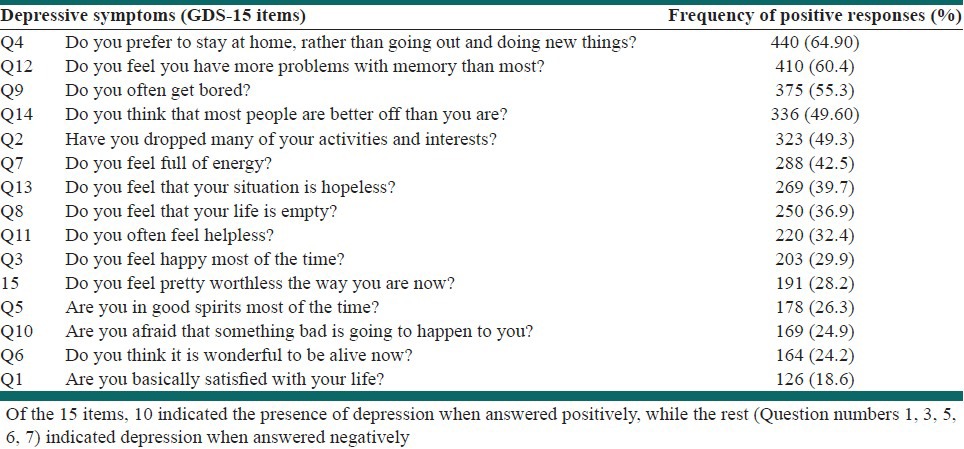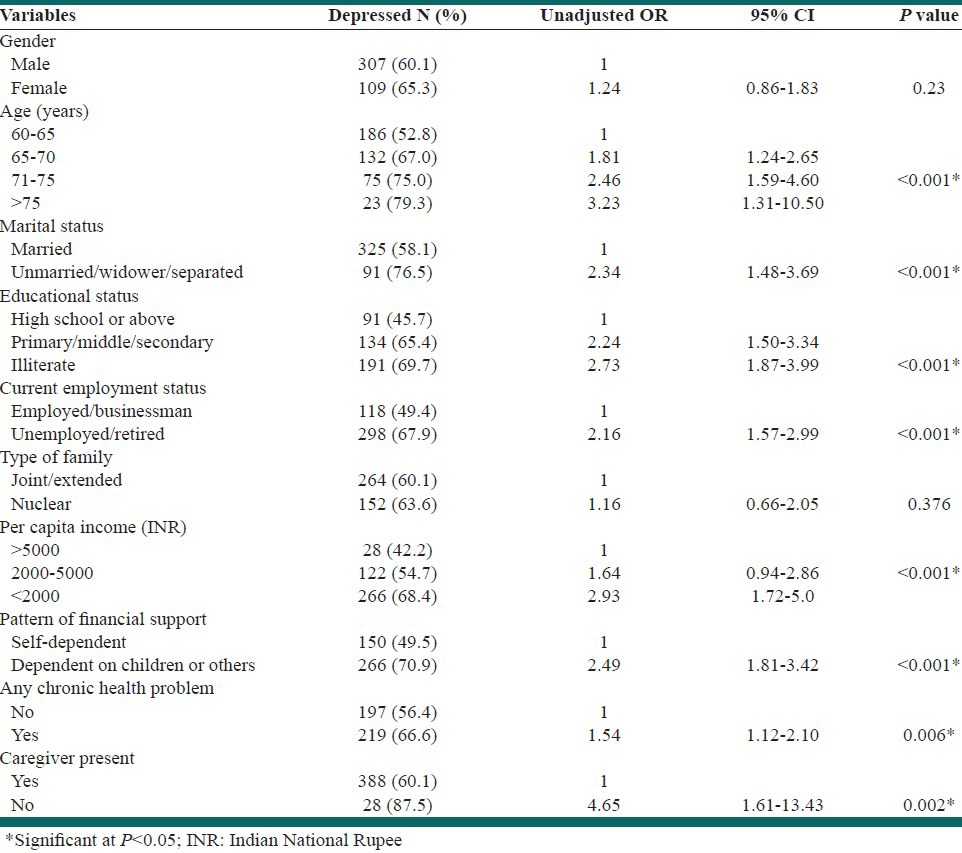Abstract
Background:
Depression is the most common geriatric psychiatric disorder. Other than organic, socio-demographic factors, have been found to play an important role in mental health. In this study we evaluated the association of some socio-demographic factors with geriatric depression
Methods:
A cross-sectional study was carried out in the Out Patient Department registration area of a tertiary care teaching hospital in Delhi. Questionnaire based interviews were conducted among the elderly people visiting the hospital. A 15-item geriatric depression scale-Hindi was used to assess depression.
Results:
Six hundred and seventy eight subjects were interviewed. The age of the subjects ranged from 65 to 85 years. About three-fourth of the study population were males. About 61.4% scored positive for depression. Multiple logistic regression analysis revealed that the following were significant (P<0.05) independent predictors of depression: Higher age, low educational status, financial dependence and presence of any chronic health problem.
Conclusions:
The present study found that the prevalence of depression among the study subjects was high. Also the independent risk factors found in this study need to be targeted in formulating mental health policy for geriatrics.
Keywords: Depression, geriatric, geriatric depression scale, socio-demographic factors
INTRODUCTION
As per world population project the proportion of elderly is going to increase from current 7% to 11% in 2025 and about 20% in 2050 with an estimated number to be 315 million.[1] Depression is the most common psychiatric disorder among the elderly which can manifest as major depression or as minor depression characterized by a collection of depressive symptoms.[2] The prevalence of depression in elderly in India is rising as reported by many community as well as hospital based studies which vary from 6% to 50%.[3]
This study was carried out to find out the prevalence and associated socio-demographic variables of depression among elderly (≥60 years) in the Out Patient Department (OPD) registration area of a tertiary care hospital in North-East Delhi.
METHODS
This cross-sectional study was conducted among elderly subjects visiting the Guru Teg Bahadur Hospital, an approximately 1200+ bedded tertiary care hospital situated in the North East district of Delhi. The study period was from 1st January to 31st January 2010.
Taking the prevalence of Depression among elderly (≥60 years) to be 40%, permissible relative error as 10% and an expected non-response rate of 10%, the sample size was calculated to be 660. Subjects were selected by convenience sampling. Those seriously ill or not able to fill the questionnaire were excluded from the study. The objectives of the study and the right to withdraw at any time were explained to the participants and and verbal consent was taken.
Data collection tool
The data collection instrument consisted of two parts. The first part comprised of socio-demographic information covering a diverse set of parameters namely age, sex, marital status, education, caregivers, employment status, financial dependence and the type of family system the subject was currently residing in. The second part was a prevalidated Hindi version of the geriatric depression scale (GDS-H) was used.[4] Depression was considered present when the score on the GDS-15 was 5 points or more. GDS-15 has a sensitivity of 85% and specificity of 75%.[5]
Statistical analysis
The data was analyzed using SPSS 16.0. Univariate statistical comparison of variables was done between the depressed and non-depressed group. A stepwise multiple logistic regression analysis was applied to determine independent predictors of depression in the elderly subjects. Type I error was fixed at 0.05.
RESULTS
Seven hundred forty potential subjects were approached in a consecutive manner with the request for participation in the study. Six hundred and ninety subjects agreed to participate, giving a response rate of 93.24%, the majority (86%) of the non-responders being females. Twelve subjects did not complete the interview due to lack of time. In the end 678 subjects were included in the final analysis.
Majority of the study subjects were in the age group of 60-65 years with a mean age of 65.13 (±4.92) years. Out of all the study subjects 75.4% were males and 82.4% were currently married. About two-fifths of the study subjects were illiterate. A large proportion (64.7%) of the elderly was either unemployed or retired and very few (2.3%) were living alone. However, 4.7% had no caregiver present.
Out of 678 study subjects 61.4% (95% CI: 57.6-65.1%) were screened positive for depression. Table 1 shows the frequency of various items included in the GDS-15 scale. Table 2 shows the percentage of depressed subjects according to various socio-demographic variables and univariate comparison of socio-demographic variables between the depressed and non-depressed groups.
Table 1.
Frequency of GDS-15 items in the study subjects (N=678), rank-ordered

Table 2.
Univariate analysis of various socio-demographic variables associated with depression in the study subjects

The variables like age, gender, marital status, education, current employment status, per capita income, pattern of financial support, any chronic health problem and presence or absence of caregiver were subjected to multiple logistic regression analysis. Multiple logistic regression analysis showed that higher age, low educational status, financial dependence and having any chronic health problems were significantly independent predictors of depression in our study subjects.
DISCUSSION
The mental health of the older population is usually a neglected domain in our country. As such, the older persons are forced to spend their last years of life with a very poor quality of life. Our study reported a high (61.4%) prevalence of depression among the study subjects. Previous Indian community-based data are limited and widely disparate, most likely reflecting non-uniform methodology. Similarly a rural community based study in Ballabgarh in Northern India revealed the prevalence of depression among population aged 55 and above to be 40%.[4] This comparatively higher prevalence of depression in present study may be due to the fact that, it is a hospital based study and the sample consisted of patients in the OPD registration area. It is known that people with co-morbid conditions are more likely to suffer from depression.[6]
Increase in age in the later life is significantly associated with an increased risk of depression. Old age is associated with various physical disabilities which lead to dependency on others for daily activities, which may be a reason for depression in elderly. Other studies have also reported similar findings.[7]
In our study, a low level of education was directly associated with depression in the elderly subjects. Many studies have reported this finding including studies in developing countries.[8,9] The educated elderly can easily adjust with the situation as compared to illiterates and therefore are at a lesser risk for depression. Elderly dependent on children, pension, charity or other family members for financial support were at higher risk (AOR=1.75, 95% CI=1.10-2.81) for depression than those who were self-dependent. Lower income and financial dependency on others for fulfillment of daily needs as well as health care expenses of a person in late life produces depressive symptoms which substantiate the findings from other authors.[7]
This study shows that presence of any chronic health problem increases the risk of depression by 1.43 times (95% CI=1.01-2.02). This corroborates with the findings of previous studies that many chronic somatic diseases like pain, diabetes, hypertension, respiratory diseases etc. are associated with not only depression but long term recurrence of depression.[6] Absence of care giver was found to be strongly associated with depression in elderly (AOR=5.68, 95% CI=1.85-17.40). Previous studies and reviews have also mentioned that negligence by the family members, lack of affection and care at the later stage of life is the most important factor for depression among elderly.10
Though females were having higher prevalence of depression, the association was not statistically significant, which is in contrast to several other studies and reviews that have shown a significant relationship of female sex with the depression.[6] This may be due to lower representation of women in our study.
Limitations
Studies have shown that the psychometric properties of the GDS are weaker when used on people with cognitive impairment.[5] Screening for people with cognitive impairment was not done in our study. Since this was a hospital based study and the study subjects were patients coming to the hospital generalizability of our results may be restricted.
CONCLUSION
The burden of depression among elderly patients is quite high and hence the risk factors found in this study should merit attention by the consulting physician.
Footnotes
Source of Support: Nil
Conflict of Interest: None declared
REFERENCES
- 1.United Nations, Department of Economic and Social Affairs, Population Division (2009). World Population Prospects: The 2008 Revision, Highlights, Working Paper No. ESA/P/WP.210 [Google Scholar]
- 2.Satcher D. Mental health: A report of the surgeon general. Executive Summary. Prof Psychol Res Pr. 2000;31:15–23. doi: 10.1093/phr/115.1.89. [DOI] [PMC free article] [PubMed] [Google Scholar]
- 3.Venkoba Rao A. Psychiatry of old age in India. Int Rev Psychiatry. 1993;5:165–70. [Google Scholar]
- 4.Ganguli M, Dube S, Johnston JM, Pandav R, Chandra V, Dodge HH. Depressive symptoms, cognitive impairment and functional impairment in a rural elderly population in India: A Hindi version of the geriatric depression scale (GDS-H) Int J Geriatr Psychiatry. 1999;14:807–20. [PubMed] [Google Scholar]
- 5.Wancata J, Alexandrowicz R, Marquart B, Weiss M, Friedrich F. The criterion validity of the Geriatric Depression Scale: a systematic review. Acta Psychiatr Scand. 2006;114:398–410. doi: 10.1111/j.1600-0447.2006.00888.x. [DOI] [PubMed] [Google Scholar]
- 6.Cole MG, Dendukuri N. Risk factors for depression among elderly community subjects: A systematic review and meta-analysis. Am J Psychiatry. 2003;160:1147–56. doi: 10.1176/appi.ajp.160.6.1147. [DOI] [PubMed] [Google Scholar]
- 7.Al-Shammari SA, Al-Subaie A. Prevalence and correlates of depression among Saudi elderly. Int J Geriatr Psychiatry. 1999;14:739–47. doi: 10.1002/(sici)1099-1166(199909)14:9<739::aid-gps998>3.0.co;2-1. [DOI] [PubMed] [Google Scholar]
- 8.Bhagwanjee A, Parekh A, Paruk Z, Petersen I, Subedar H. Prevalence of minor psychiatric disorders in an adult African rural community in South Africa. Psychol Med. 1998;28:1137–47. doi: 10.1017/s0033291798006965. [DOI] [PubMed] [Google Scholar]
- 9.Kim JM, Shin IS, Yoon JS, Stewart R. Prevalence and correlates of late-life depression compared between urban and rural populations in Korea. Int J Geriatr Psychiatry. 2002;17:409–15. doi: 10.1002/gps.622. [DOI] [PubMed] [Google Scholar]


